Considerations for Aging Populations: A Dermatology Essay
VerifiedAdded on 2022/10/11
|5
|1404
|13
Essay
AI Summary
This essay delves into the field of dermatology, focusing on the complexities of aging skin. It begins by defining dermatology and its focus on skin-related diseases and disorders. The essay then explores the visible signs of aging, such as wrinkles and roughness, and introduces the concepts of intrinsic and extrinsic aging. The core of the essay examines current theories of aging, categorizing them into programmed and error theories. Programmed theories, including programmed longevity, endocrine theory, and immunological theory, are discussed in detail. The essay also covers the damage or error theories, including wear and tear, rate of living, cross-linking, free radicals, and somatic DNA damage theories. Furthermore, the essay analyzes the psychological effects of aging skin, such as decreased self-esteem, loneliness, and stress, and how these factors impact an individual's well-being, social relationships, and mental health. The conclusion summarizes the key points, emphasizing the importance of understanding aging skin and its psychological influences for appropriate interventions. The essay is supported by references to relevant research and literature.
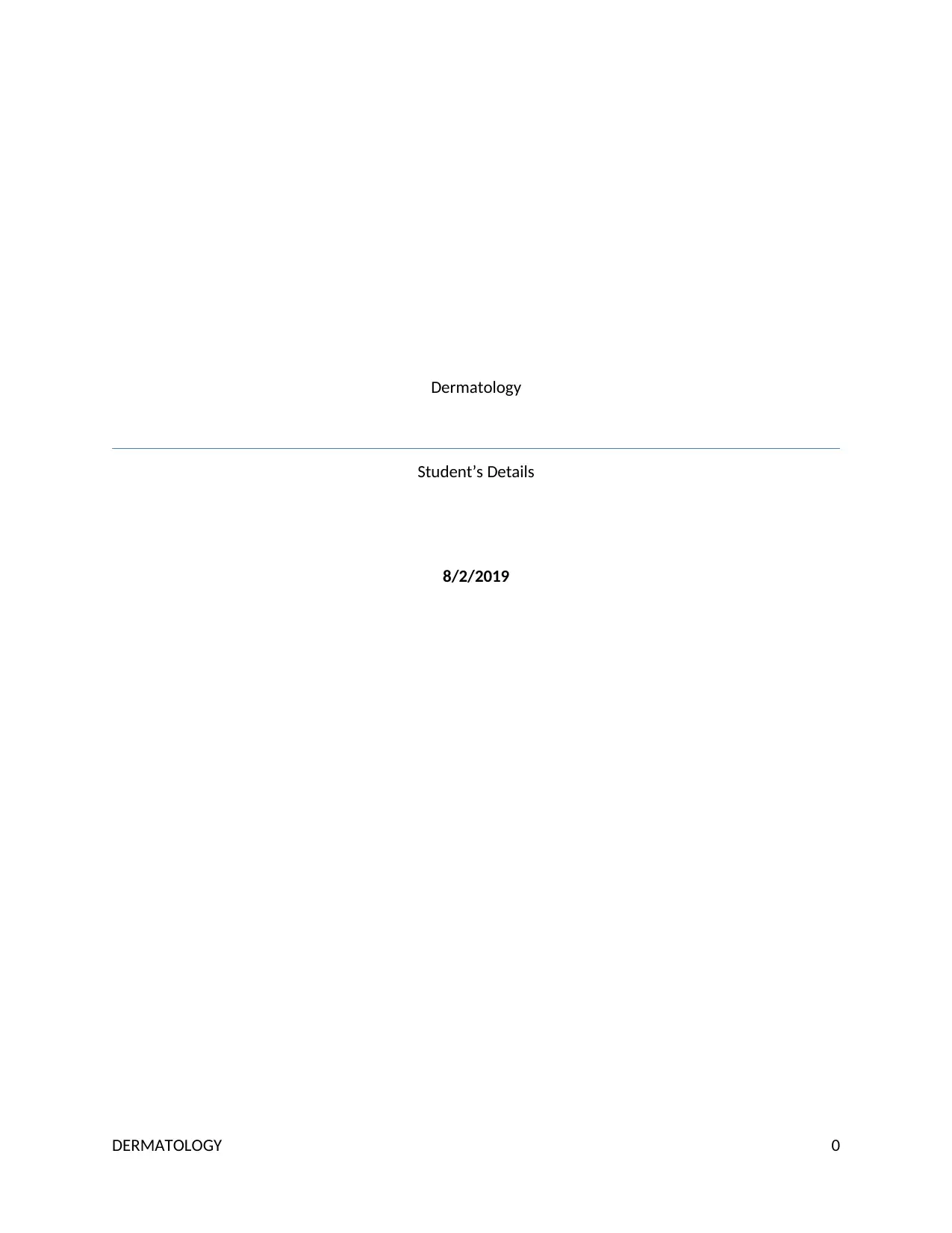
Dermatology
Student’s Details
8/2/2019
DERMATOLOGY 0
Student’s Details
8/2/2019
DERMATOLOGY 0
Paraphrase This Document
Need a fresh take? Get an instant paraphrase of this document with our AI Paraphraser
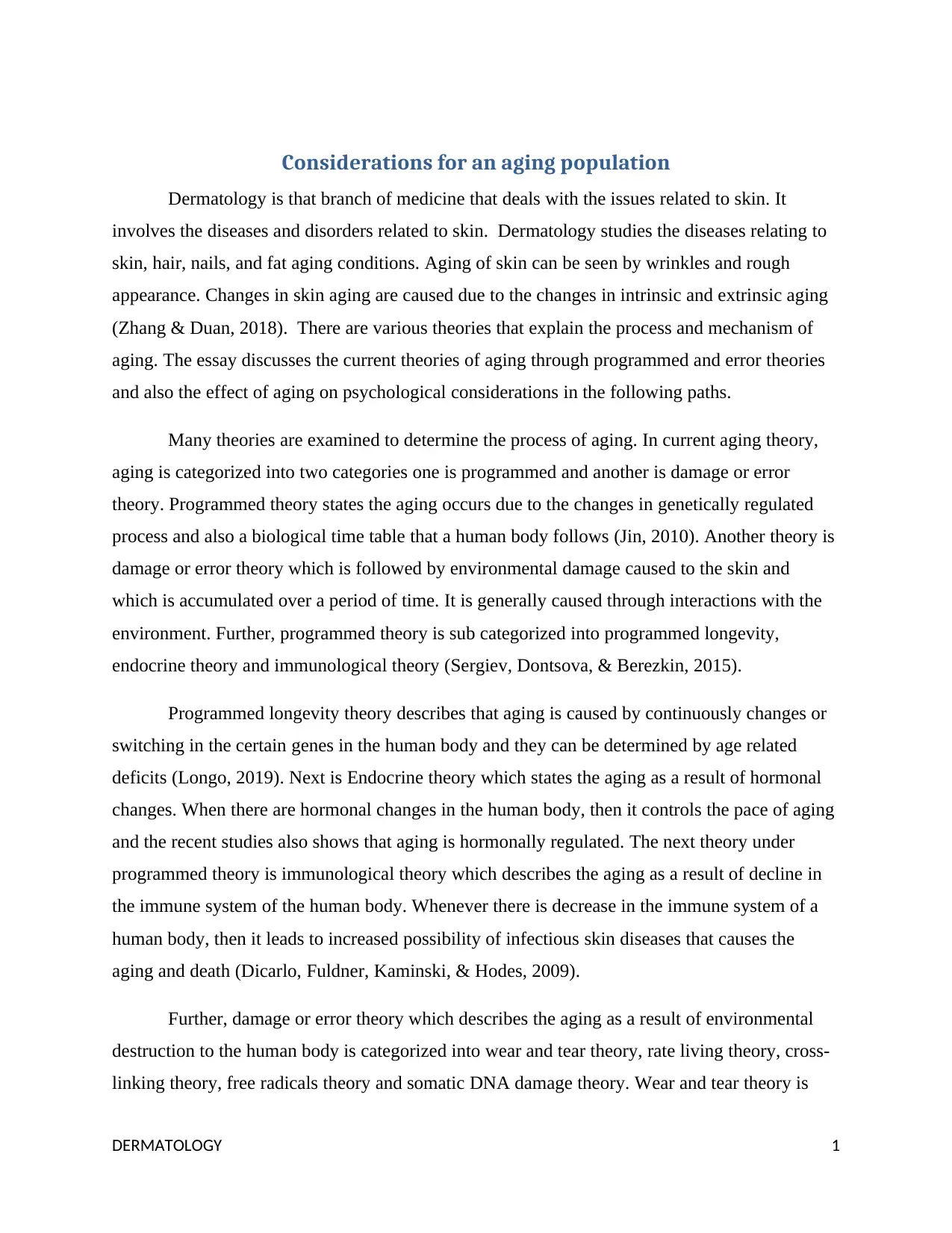
Considerations for an aging population
Dermatology is that branch of medicine that deals with the issues related to skin. It
involves the diseases and disorders related to skin. Dermatology studies the diseases relating to
skin, hair, nails, and fat aging conditions. Aging of skin can be seen by wrinkles and rough
appearance. Changes in skin aging are caused due to the changes in intrinsic and extrinsic aging
(Zhang & Duan, 2018). There are various theories that explain the process and mechanism of
aging. The essay discusses the current theories of aging through programmed and error theories
and also the effect of aging on psychological considerations in the following paths.
Many theories are examined to determine the process of aging. In current aging theory,
aging is categorized into two categories one is programmed and another is damage or error
theory. Programmed theory states the aging occurs due to the changes in genetically regulated
process and also a biological time table that a human body follows (Jin, 2010). Another theory is
damage or error theory which is followed by environmental damage caused to the skin and
which is accumulated over a period of time. It is generally caused through interactions with the
environment. Further, programmed theory is sub categorized into programmed longevity,
endocrine theory and immunological theory (Sergiev, Dontsova, & Berezkin, 2015).
Programmed longevity theory describes that aging is caused by continuously changes or
switching in the certain genes in the human body and they can be determined by age related
deficits (Longo, 2019). Next is Endocrine theory which states the aging as a result of hormonal
changes. When there are hormonal changes in the human body, then it controls the pace of aging
and the recent studies also shows that aging is hormonally regulated. The next theory under
programmed theory is immunological theory which describes the aging as a result of decline in
the immune system of the human body. Whenever there is decrease in the immune system of a
human body, then it leads to increased possibility of infectious skin diseases that causes the
aging and death (Dicarlo, Fuldner, Kaminski, & Hodes, 2009).
Further, damage or error theory which describes the aging as a result of environmental
destruction to the human body is categorized into wear and tear theory, rate living theory, cross-
linking theory, free radicals theory and somatic DNA damage theory. Wear and tear theory is
DERMATOLOGY 1
Dermatology is that branch of medicine that deals with the issues related to skin. It
involves the diseases and disorders related to skin. Dermatology studies the diseases relating to
skin, hair, nails, and fat aging conditions. Aging of skin can be seen by wrinkles and rough
appearance. Changes in skin aging are caused due to the changes in intrinsic and extrinsic aging
(Zhang & Duan, 2018). There are various theories that explain the process and mechanism of
aging. The essay discusses the current theories of aging through programmed and error theories
and also the effect of aging on psychological considerations in the following paths.
Many theories are examined to determine the process of aging. In current aging theory,
aging is categorized into two categories one is programmed and another is damage or error
theory. Programmed theory states the aging occurs due to the changes in genetically regulated
process and also a biological time table that a human body follows (Jin, 2010). Another theory is
damage or error theory which is followed by environmental damage caused to the skin and
which is accumulated over a period of time. It is generally caused through interactions with the
environment. Further, programmed theory is sub categorized into programmed longevity,
endocrine theory and immunological theory (Sergiev, Dontsova, & Berezkin, 2015).
Programmed longevity theory describes that aging is caused by continuously changes or
switching in the certain genes in the human body and they can be determined by age related
deficits (Longo, 2019). Next is Endocrine theory which states the aging as a result of hormonal
changes. When there are hormonal changes in the human body, then it controls the pace of aging
and the recent studies also shows that aging is hormonally regulated. The next theory under
programmed theory is immunological theory which describes the aging as a result of decline in
the immune system of the human body. Whenever there is decrease in the immune system of a
human body, then it leads to increased possibility of infectious skin diseases that causes the
aging and death (Dicarlo, Fuldner, Kaminski, & Hodes, 2009).
Further, damage or error theory which describes the aging as a result of environmental
destruction to the human body is categorized into wear and tear theory, rate living theory, cross-
linking theory, free radicals theory and somatic DNA damage theory. Wear and tear theory is
DERMATOLOGY 1
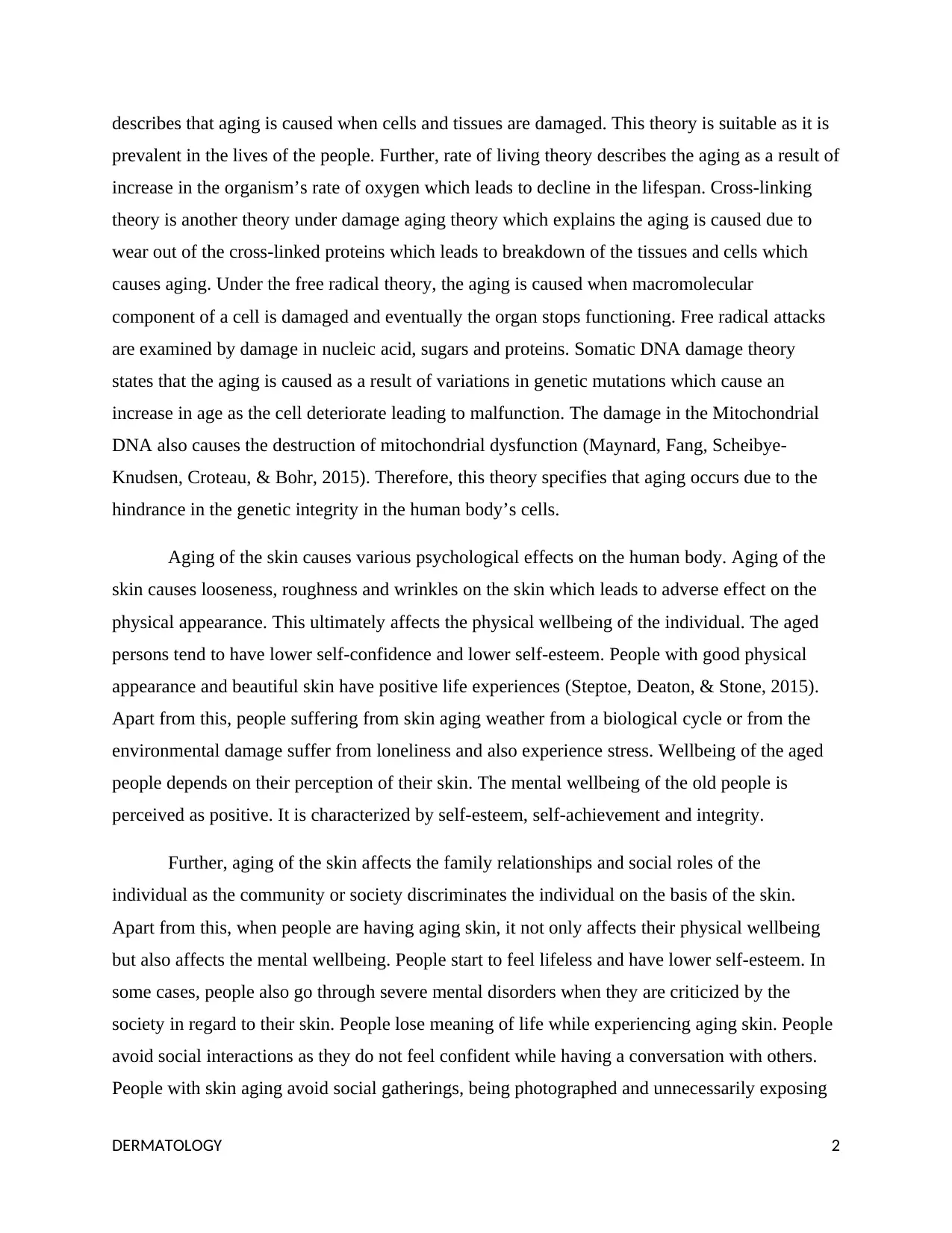
describes that aging is caused when cells and tissues are damaged. This theory is suitable as it is
prevalent in the lives of the people. Further, rate of living theory describes the aging as a result of
increase in the organism’s rate of oxygen which leads to decline in the lifespan. Cross-linking
theory is another theory under damage aging theory which explains the aging is caused due to
wear out of the cross-linked proteins which leads to breakdown of the tissues and cells which
causes aging. Under the free radical theory, the aging is caused when macromolecular
component of a cell is damaged and eventually the organ stops functioning. Free radical attacks
are examined by damage in nucleic acid, sugars and proteins. Somatic DNA damage theory
states that the aging is caused as a result of variations in genetic mutations which cause an
increase in age as the cell deteriorate leading to malfunction. The damage in the Mitochondrial
DNA also causes the destruction of mitochondrial dysfunction (Maynard, Fang, Scheibye-
Knudsen, Croteau, & Bohr, 2015). Therefore, this theory specifies that aging occurs due to the
hindrance in the genetic integrity in the human body’s cells.
Aging of the skin causes various psychological effects on the human body. Aging of the
skin causes looseness, roughness and wrinkles on the skin which leads to adverse effect on the
physical appearance. This ultimately affects the physical wellbeing of the individual. The aged
persons tend to have lower self-confidence and lower self-esteem. People with good physical
appearance and beautiful skin have positive life experiences (Steptoe, Deaton, & Stone, 2015).
Apart from this, people suffering from skin aging weather from a biological cycle or from the
environmental damage suffer from loneliness and also experience stress. Wellbeing of the aged
people depends on their perception of their skin. The mental wellbeing of the old people is
perceived as positive. It is characterized by self-esteem, self-achievement and integrity.
Further, aging of the skin affects the family relationships and social roles of the
individual as the community or society discriminates the individual on the basis of the skin.
Apart from this, when people are having aging skin, it not only affects their physical wellbeing
but also affects the mental wellbeing. People start to feel lifeless and have lower self-esteem. In
some cases, people also go through severe mental disorders when they are criticized by the
society in regard to their skin. People lose meaning of life while experiencing aging skin. People
avoid social interactions as they do not feel confident while having a conversation with others.
People with skin aging avoid social gatherings, being photographed and unnecessarily exposing
DERMATOLOGY 2
prevalent in the lives of the people. Further, rate of living theory describes the aging as a result of
increase in the organism’s rate of oxygen which leads to decline in the lifespan. Cross-linking
theory is another theory under damage aging theory which explains the aging is caused due to
wear out of the cross-linked proteins which leads to breakdown of the tissues and cells which
causes aging. Under the free radical theory, the aging is caused when macromolecular
component of a cell is damaged and eventually the organ stops functioning. Free radical attacks
are examined by damage in nucleic acid, sugars and proteins. Somatic DNA damage theory
states that the aging is caused as a result of variations in genetic mutations which cause an
increase in age as the cell deteriorate leading to malfunction. The damage in the Mitochondrial
DNA also causes the destruction of mitochondrial dysfunction (Maynard, Fang, Scheibye-
Knudsen, Croteau, & Bohr, 2015). Therefore, this theory specifies that aging occurs due to the
hindrance in the genetic integrity in the human body’s cells.
Aging of the skin causes various psychological effects on the human body. Aging of the
skin causes looseness, roughness and wrinkles on the skin which leads to adverse effect on the
physical appearance. This ultimately affects the physical wellbeing of the individual. The aged
persons tend to have lower self-confidence and lower self-esteem. People with good physical
appearance and beautiful skin have positive life experiences (Steptoe, Deaton, & Stone, 2015).
Apart from this, people suffering from skin aging weather from a biological cycle or from the
environmental damage suffer from loneliness and also experience stress. Wellbeing of the aged
people depends on their perception of their skin. The mental wellbeing of the old people is
perceived as positive. It is characterized by self-esteem, self-achievement and integrity.
Further, aging of the skin affects the family relationships and social roles of the
individual as the community or society discriminates the individual on the basis of the skin.
Apart from this, when people are having aging skin, it not only affects their physical wellbeing
but also affects the mental wellbeing. People start to feel lifeless and have lower self-esteem. In
some cases, people also go through severe mental disorders when they are criticized by the
society in regard to their skin. People lose meaning of life while experiencing aging skin. People
avoid social interactions as they do not feel confident while having a conversation with others.
People with skin aging avoid social gatherings, being photographed and unnecessarily exposing
DERMATOLOGY 2
⊘ This is a preview!⊘
Do you want full access?
Subscribe today to unlock all pages.

Trusted by 1+ million students worldwide
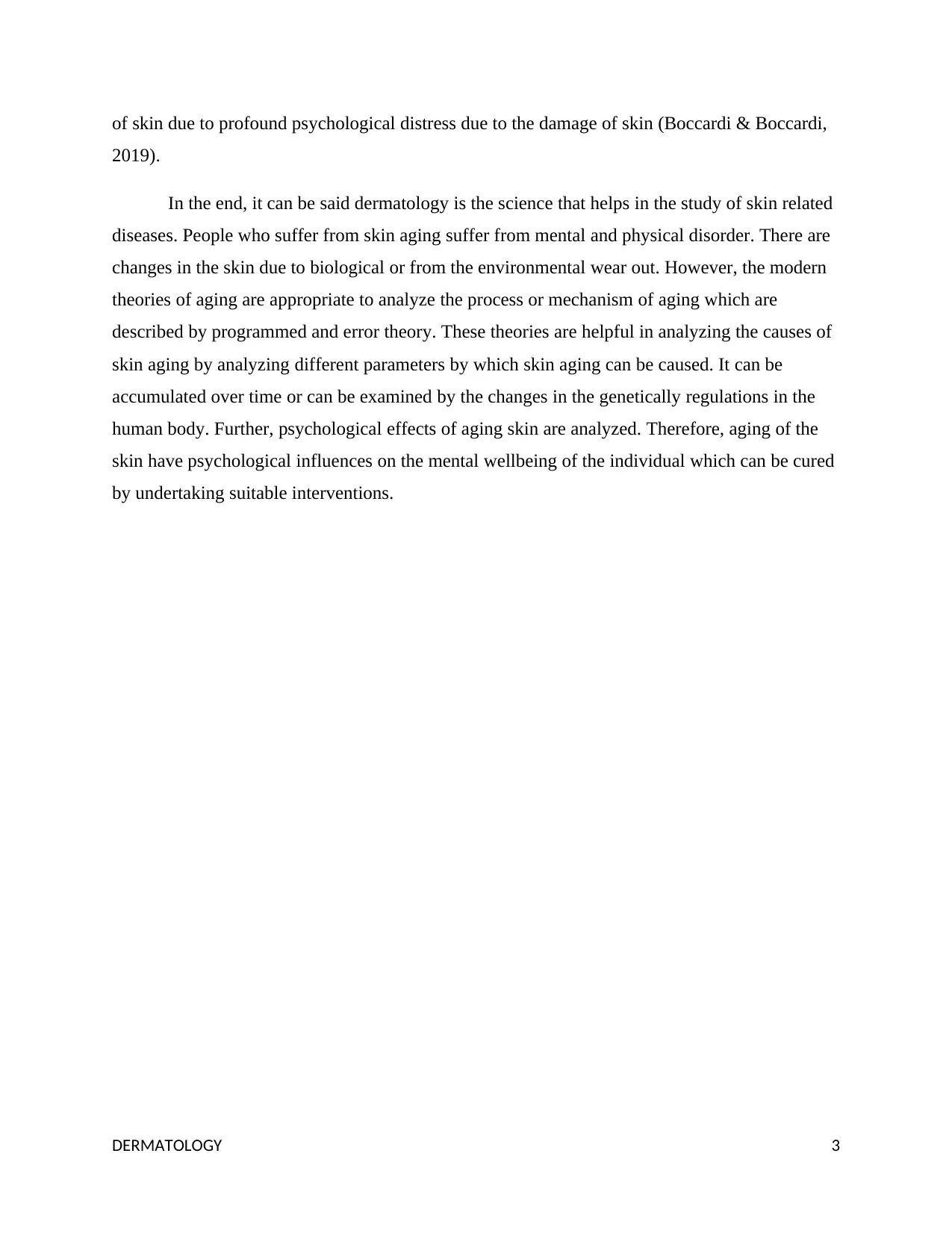
of skin due to profound psychological distress due to the damage of skin (Boccardi & Boccardi,
2019).
In the end, it can be said dermatology is the science that helps in the study of skin related
diseases. People who suffer from skin aging suffer from mental and physical disorder. There are
changes in the skin due to biological or from the environmental wear out. However, the modern
theories of aging are appropriate to analyze the process or mechanism of aging which are
described by programmed and error theory. These theories are helpful in analyzing the causes of
skin aging by analyzing different parameters by which skin aging can be caused. It can be
accumulated over time or can be examined by the changes in the genetically regulations in the
human body. Further, psychological effects of aging skin are analyzed. Therefore, aging of the
skin have psychological influences on the mental wellbeing of the individual which can be cured
by undertaking suitable interventions.
DERMATOLOGY 3
2019).
In the end, it can be said dermatology is the science that helps in the study of skin related
diseases. People who suffer from skin aging suffer from mental and physical disorder. There are
changes in the skin due to biological or from the environmental wear out. However, the modern
theories of aging are appropriate to analyze the process or mechanism of aging which are
described by programmed and error theory. These theories are helpful in analyzing the causes of
skin aging by analyzing different parameters by which skin aging can be caused. It can be
accumulated over time or can be examined by the changes in the genetically regulations in the
human body. Further, psychological effects of aging skin are analyzed. Therefore, aging of the
skin have psychological influences on the mental wellbeing of the individual which can be cured
by undertaking suitable interventions.
DERMATOLOGY 3
Paraphrase This Document
Need a fresh take? Get an instant paraphrase of this document with our AI Paraphraser
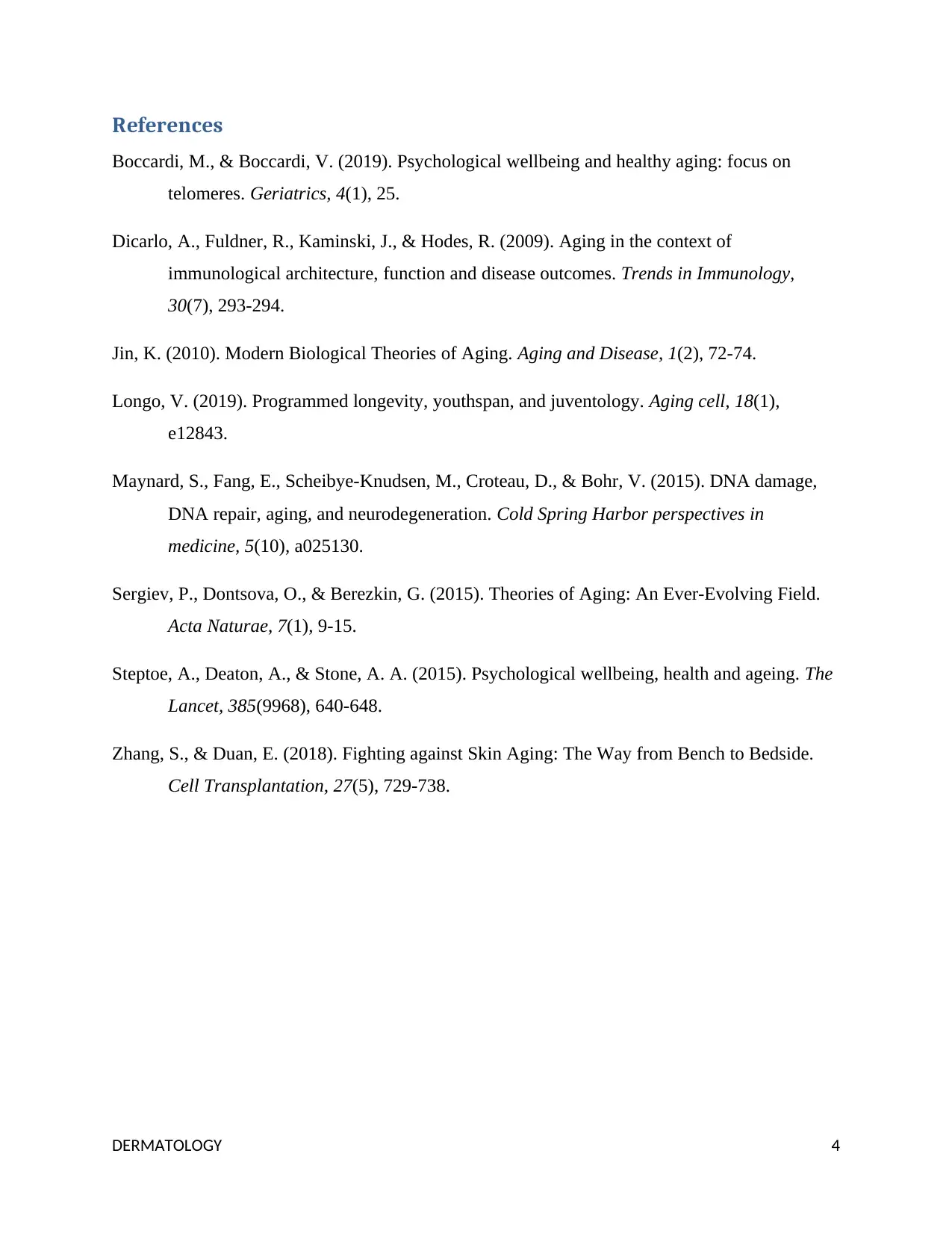
References
Boccardi, M., & Boccardi, V. (2019). Psychological wellbeing and healthy aging: focus on
telomeres. Geriatrics, 4(1), 25.
Dicarlo, A., Fuldner, R., Kaminski, J., & Hodes, R. (2009). Aging in the context of
immunological architecture, function and disease outcomes. Trends in Immunology,
30(7), 293-294.
Jin, K. (2010). Modern Biological Theories of Aging. Aging and Disease, 1(2), 72-74.
Longo, V. (2019). Programmed longevity, youthspan, and juventology. Aging cell, 18(1),
e12843.
Maynard, S., Fang, E., Scheibye-Knudsen, M., Croteau, D., & Bohr, V. (2015). DNA damage,
DNA repair, aging, and neurodegeneration. Cold Spring Harbor perspectives in
medicine, 5(10), a025130.
Sergiev, P., Dontsova, O., & Berezkin, G. (2015). Theories of Aging: An Ever-Evolving Field.
Acta Naturae, 7(1), 9-15.
Steptoe, A., Deaton, A., & Stone, A. A. (2015). Psychological wellbeing, health and ageing. The
Lancet, 385(9968), 640-648.
Zhang, S., & Duan, E. (2018). Fighting against Skin Aging: The Way from Bench to Bedside.
Cell Transplantation, 27(5), 729-738.
DERMATOLOGY 4
Boccardi, M., & Boccardi, V. (2019). Psychological wellbeing and healthy aging: focus on
telomeres. Geriatrics, 4(1), 25.
Dicarlo, A., Fuldner, R., Kaminski, J., & Hodes, R. (2009). Aging in the context of
immunological architecture, function and disease outcomes. Trends in Immunology,
30(7), 293-294.
Jin, K. (2010). Modern Biological Theories of Aging. Aging and Disease, 1(2), 72-74.
Longo, V. (2019). Programmed longevity, youthspan, and juventology. Aging cell, 18(1),
e12843.
Maynard, S., Fang, E., Scheibye-Knudsen, M., Croteau, D., & Bohr, V. (2015). DNA damage,
DNA repair, aging, and neurodegeneration. Cold Spring Harbor perspectives in
medicine, 5(10), a025130.
Sergiev, P., Dontsova, O., & Berezkin, G. (2015). Theories of Aging: An Ever-Evolving Field.
Acta Naturae, 7(1), 9-15.
Steptoe, A., Deaton, A., & Stone, A. A. (2015). Psychological wellbeing, health and ageing. The
Lancet, 385(9968), 640-648.
Zhang, S., & Duan, E. (2018). Fighting against Skin Aging: The Way from Bench to Bedside.
Cell Transplantation, 27(5), 729-738.
DERMATOLOGY 4
1 out of 5
Related Documents
Your All-in-One AI-Powered Toolkit for Academic Success.
+13062052269
info@desklib.com
Available 24*7 on WhatsApp / Email
![[object Object]](/_next/static/media/star-bottom.7253800d.svg)
Unlock your academic potential
Copyright © 2020–2025 A2Z Services. All Rights Reserved. Developed and managed by ZUCOL.



